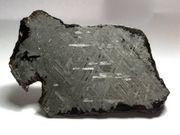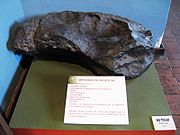
Octahedrite
Encyclopedia


Iron meteorite
Iron meteorites are meteorites that consist overwhelmingly of nickel-iron alloys. The metal taken from these meteorites is known as meteoric iron and was one of the earliest sources of usable iron available to humans.-Occurrence:...
s within the structural classification. They are the most common class of iron meteorites.
They are composed primarily of the nickel
Nickel
Nickel is a chemical element with the chemical symbol Ni and atomic number 28. It is a silvery-white lustrous metal with a slight golden tinge. Nickel belongs to the transition metals and is hard and ductile...
-iron
Iron
Iron is a chemical element with the symbol Fe and atomic number 26. It is a metal in the first transition series. It is the most common element forming the planet Earth as a whole, forming much of Earth's outer and inner core. It is the fourth most common element in the Earth's crust...
alloy
Alloy
An alloy is a mixture or metallic solid solution composed of two or more elements. Complete solid solution alloys give single solid phase microstructure, while partial solutions give two or more phases that may or may not be homogeneous in distribution, depending on thermal history...
s: taenite
Taenite
Taenite is a mineral found naturally on Earth mostly in iron meteorites. It is an alloy of iron and nickel, with nickel proportions of 20% up to 65%.The name is derived from the Greek for "band". Taenite is a major constituent of iron meteorites...
- high nickel content, and kamacite
Kamacite
Kamacite is a mineral. It is an alloy of iron and nickel, usually in the proportions of 90:10 to 95:5 although impurities such as cobalt or carbon may be present. On the surface of Earth, it occurs naturally only in meteorites. It has a metallic luster, is gray and has no clear cleavage although...
- low nickel content.
Structure
Due to a long cooling time in the interior of the parent asteroidAsteroid
Asteroids are a class of small Solar System bodies in orbit around the Sun. They have also been called planetoids, especially the larger ones...
s, these alloys have crystallized into intermixed millimeter-sized bands (from about 0.2 mm to 5 cm). When polished and acid etched the classic Widmanstätten pattern
Widmanstätten pattern
Widmanstätten patterns, also called Thomson structures, are unique figures of long nickel-iron crystals, found in the octahedrite iron meteorites and some pallasites. They consist of a fine interleaving of kamacite and taenite bands or ribbons called lamellæ...
s of intersecting lines of lamellar kamacite, are visible.
In gaps between the kamacite and taenite lamellae, a fine-grained mixture called plessite
Plessite
Plessite is a meteorite texture consisting of a fine-grained mixture of the minerals kamacite and taenite found in the octahedrite iron meteorites. It occurs in gaps between the larger bands of kamacite and taenite which form Widmanstätten patterns....
is often found. An iron nickel phosphide, schreibersite
Schreibersite
Schreibersite is generally a rare iron nickel phosphide mineral, 3P, though common in iron-nickel meteorites. It is rarely reported from Earth . Another name used for the mineral is rhabdite. It forms tetragonal crystals with perfect 001 cleavage. Its color ranges from bronze to brass yellow to...
, is present in most nickel-iron meteorites, as well as an iron-nickel-cobalt
Cobalt
Cobalt is a chemical element with symbol Co and atomic number 27. It is found naturally only in chemically combined form. The free element, produced by reductive smelting, is a hard, lustrous, silver-gray metal....
carbide
Carbide
In chemistry, a carbide is a compound composed of carbon and a less electronegative element. Carbides can be generally classified by chemical bonding type as follows: salt-like, covalent compounds, interstitial compounds, and "intermediate" transition metal carbides...
, cohenite
Cohenite
Cohenite is a naturally occurring iron mineral with the chemical structure 3C. This forms a hard, shiny, silver mineral which was named by E. Weinschenk in 1889 after the German mineralogist Emil Cohen, who first described and analysed it. Cohenite is found in rod-like crystals in iron meteorites...
. Graphite
Graphite
The mineral graphite is one of the allotropes of carbon. It was named by Abraham Gottlob Werner in 1789 from the Ancient Greek γράφω , "to draw/write", for its use in pencils, where it is commonly called lead . Unlike diamond , graphite is an electrical conductor, a semimetal...
and troilite
Troilite
Troilite is a rare iron sulfide mineral with the simple formula of FeS. It is the iron rich endmember of the pyrrhotite group. Pyrrhotite has the formula FeS which is iron deficient...
occur in rounded nodules up to several cm in size.
Classification
Octahedrites can be grouped by the dimensions of kamacite lamellae in the Widmanstätten patternWidmanstätten pattern
Widmanstätten patterns, also called Thomson structures, are unique figures of long nickel-iron crystals, found in the octahedrite iron meteorites and some pallasites. They consist of a fine interleaving of kamacite and taenite bands or ribbons called lamellæ...
, which are related to the nickel
Nickel
Nickel is a chemical element with the chemical symbol Ni and atomic number 28. It is a silvery-white lustrous metal with a slight golden tinge. Nickel belongs to the transition metals and is hard and ductile...
content:
- Coarsest octahedrites, lamellae width >3.3 mm, 5-9% Ni, symbol Ogg
- Coarse octahedrites, lamellae 1.3-3.3 mm, 6.5-8.5% Ni, symbol Og
- Medium octahedrites, lamellae 0.5-1.3 mm, 7-13% Ni, symbol Om
- Fine octahedrites, lamellae 0.2-0.5 mm, 7.5-13% Ni, symbol Of
- Finest octahedrites, lamellae <0.2 mm, 17-18% Ni, symbol Off
- Plessitic octahedrites, kamacite spindles, a transitional structure between octahedrites and ataxites, 9-18% Ni, symbol Opl
Mineral
Octahedrite is also an obsolete synonym for anataseAnatase
Anatase is one of the three mineral forms of titanium dioxide, the other two being brookite and rutile. It is always found as small, isolated and sharply developed crystals, and like rutile, a more commonly occurring modification of titanium dioxide, it crystallizes in the tetragonal system; but,...
, one of the three known titanium
Titanium
Titanium is a chemical element with the symbol Ti and atomic number 22. It has a low density and is a strong, lustrous, corrosion-resistant transition metal with a silver color....
dioxide mineral
Mineral
A mineral is a naturally occurring solid chemical substance formed through biogeochemical processes, having characteristic chemical composition, highly ordered atomic structure, and specific physical properties. By comparison, a rock is an aggregate of minerals and/or mineraloids and does not...
s.

